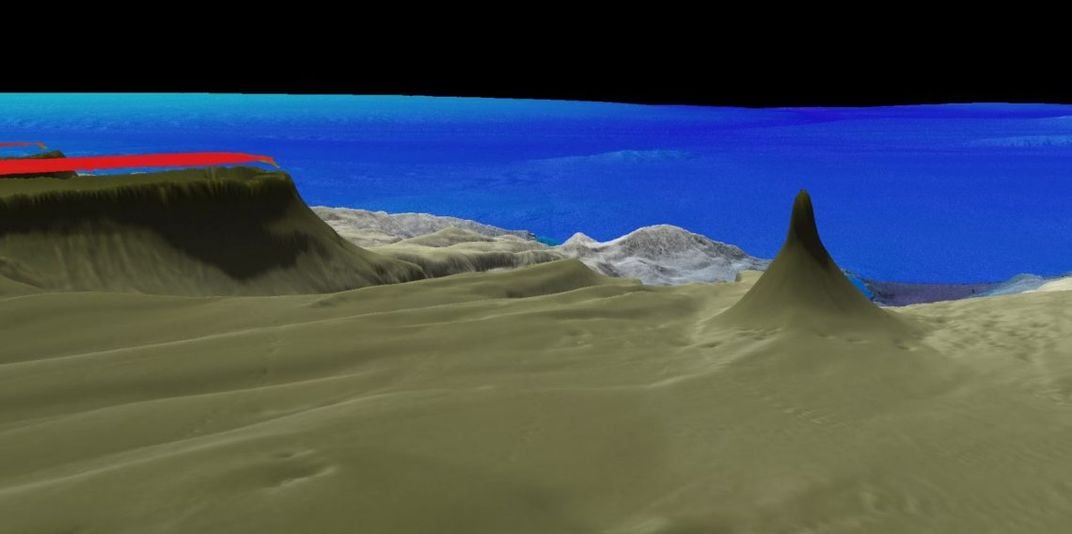A Coral Reef Taller Than the Eiffel Tower Was Just Discovered Off the Coast of Australia
A team of scientists mapped the underwater landscape and its bustling sea life using a robot
:focal(488x331:489x332)/https://tf-cmsv2-smithsonianmag-media.s3.amazonaws.com/filer/34/6c/346cc9f0-03fa-4fd0-b311-026786b48336/fk200802-falkorribbonreef5-20200817-miller-1140x599.jpg)
Imagine the Eiffel Tower was built on the ocean floor. Instead of iron plates and beams, the structure was sculpted with rock and coral, surrounded by fish, sharks and other sea critters swirling around its towering heights.
That's essentially what scientists recently discovered off the coast of Australia, reports Adam Morton for The Guardian.
On October 20, a team of scientists detected a coral reef measuring 1,640 feet tall—600 feet taller than the Eiffel Tower—embedded in the seafloor near the northern edge of the Great Barrier Reef.
"To find a new half-a-kilometer tall reef in the offshore Cape York area of the well-recognized Great Barrier Reef shows how mysterious the world is just beyond our coastline," Jyotika Virmani, the executive director of Schmidt Ocean Institute, says in a press release.
A team of scientists on board the Schmidt Ocean Institute's research vessel Falkor were on a year-long expedition to map the seafloor surrounding Australia when they discovered the reef about 80 miles off the coast of Cape York, Queensland. The "blade-like" reef is nearly a mile wide at its base and extends vertically so that the top reaches 130 feet below the surface, reports Reuters.
It's the first detached reef of that size to be discovered in more than a hundred years, making it a thrilling find for the scientists, reports George Dvorsky for Gizmodo. Detached reefs are stand-alone structures, so although close in proximity, this new reef is not connected to the Great Barrier Reef. Instead, it's embedded deep in the seafloor. The structure is estimated to be around 20 million years old.
The new find is one of eight detached reefs within a 93-mile span, but the rest were mapped in the 1880s, reports Gizmodo.

"It’s a big reef not to have known about," expedition leader Tom Bridge, a marine ecologist at James Cook University, tells The Guardian. "What it highlights is how little we know about a lot of the ocean, even the Great Barrier Reef. The marine park is 344,000 square kilometers—bigger than many European countries—and only about six or seven percent of that is typical shallow-water reefs."
Upon discovering the mountain-like reef, the team deployed an underwater robot named SuBastian to document the reef and collect samples.
"We are surprised and elated by what we have found,” Robin Beaman, a marine geologist at James Cook University in Australia, says in the press release. "To not only 3-D map the reef in detail but [to] also visually see this discovery with SuBastian is incredible."
SuBastian's footage revealed that the reef has soft corals, sponges and sea fans in its upper section instead of hard corals, suggesting that strong currents and upwellings are funneling rich nutrients to the reef, keeping it healthy. The robot also documented a "blizzard of fish," including various shark species, and collected samples from the reef, Beaman tells Reuters. CNN reports Great Barrier Reef has lost 50 percent of its coral populations within the last three decades, but Beaman says that this reef hasn't shown any signs of damage yet.
Isolated seamounts like this are critical habitats for marine life, especially since corals across the world are disappearing. Since they develop in isolation, they can give rise to unique communities of wildlife and even to the emergence of new species, reports Gizmodo.
Scientists will likely study the reef and its inhabitants extensively in the coming years as they use "this powerful combination of mapping data and underwater imagery…to understand this new reef and its role within the incredible Great Barrier Reef World Heritage Area," Virmani says.
/https://tf-cmsv2-smithsonianmag-media.s3.amazonaws.com/accounts/headshot/rasha.png)


/https://tf-cmsv2-smithsonianmag-media.s3.amazonaws.com/accounts/headshot/rasha.png)